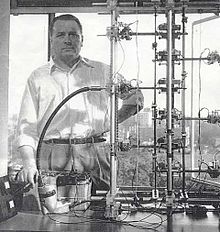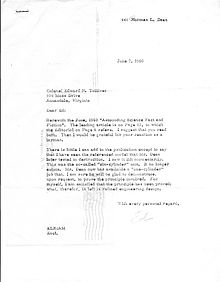- Dean drive
-
The Dean drive is a device intended to be a reactionless thruster that was invented by Norman L. Dean. Dean claimed that it was able to generate a uni-directional force, in violation of Newton's Third Law of Motion. Such a violation is generally considered to be impossible in physics. While it is theoretically possible for a mass that moves in one direction to have its momentum balanced by something other than a reaction mass (e.g. see Nuclear photonic rocket), there is no known theoretical mechanism for a mass to be moved one way while nothing moves the other way, at least in a flat spacetime.
An actual functioning "reactionless thruster" would, of course, have enormous application, completely changing human transport, engineering, space travel and more.
According to Dean, his drive is a reactionless thruster, and his models were able to demonstrate this effect. He received two patents for related devices that are known to be unable to generate a uni-directional force, but he occasionally demonstrated devices that were different.[1][2] Dean's claims of reactionless thrust generation have subsequently been shown to be in error; the thrust generated is understood to be reliant on friction with the surface on which the device is resting.[3][4]
Contents
Early publicity
The Dean drive obtained a good deal of publicity in the 1950s and 1960s via the columns of John W. Campbell, the longtime editor of Astounding Science Fiction magazine. Campbell believed that the device worked and claimed to have witnessed it operating on a bathroom scale.[5] The weight reading on the scale appeared to decrease when the device was activated. He subsequently published photographs of the scale with the drive stopped and running. The June 1960 cover of Astounding magazine featured a painting of a United States submarine near Mars, supposedly propelled there by a Dean drive.[6]
Dean, who was trying to find potential buyers for his technology, was secretive about the details of how it was supposed to work, but it was said to contain asymmetrical rotating weights and to generate a great deal of vibration.
Dean and Campbell claimed that Newton’s laws of motion were only an approximation, and that Dean had discovered a fourth law of motion. This has been described as a nonlinear correction to one of Newton’s laws, which, if correct, would allegedly have rendered a reactionless drive feasible after all.
One result of the initial articles in Campbell's magazine was that two other researchers, William O. Davis and G. Harry Stine, visited Dean and witnessed a demonstration. Results of this visit were published in the May 1962 and June 1976 issues of the magazine, the name of which had been changed by Campbell from Astounding to Analog. Davis wrote: "It was the conclusion of both Harry Stine and myself that we had witnessed a real anomaly and that the possibility of fraud in the demonstration was slim."[2]
Davis' 1962 article was titled, "The Fourth Law of Motion", and described a hypothesis in which Dean's device (and others) could conserve momentum invisibly via "gravitational-inertial radiation". One detail of Davis' hypothesis involved the forces of action and reaction — physical bodies can respond to those forces nonsimultaneously, or "out of phase" with each other.
Stine was an engineer who built devices to test that aspect of the hypothesis. In his 1976 article, "Detesters, Phasers and Dean Drives", Stine claimed they were able to reliably create and reproduce a 3-degree phase angle. Their research was terminated when the national economy took a downturn, and was never resumed. The 1976 article was an attempt to get research re-started, but apparently failed.
Purported weight loss
The interactions of vibration, friction, resonance with the springs of the scale are considered to be the root cause of the apparent weight loss reported by Campbell. Dean's patented devices, and his explanation of how his Drive was supposed to work, were later shown to develop no net weight loss over time and do not violate Newton's Third Law of Motion.[3][5] However, one version of the actually-demonstrated "Dean Drive", while suspended above the ground, was able to pull a load to itself without itself being pulled toward the load.[1] Another version of the machine was able to apply a force to a hand, without moving—yet when the machine was turned off an equivalent force applied by the hand easily moved the machine.[2] Dr. William O. Davis, who witnessed the latter demonstration, wrote in his notebook about Dean's explanation of how the device worked, "... does not strike me as valid ... For this reason I have decided to undertake a theoretical study of dynamic systems to see if a concept can be evolved which will describe a world in which Dean's Drive can exist and yet where other known facts are not contradicted."[2] He succeeded at devising such a concept, and it was published.[7]
Interested parties
As early as 1961 Dean was featured in Popular Mechanics Magazine. The article was titled "Engine with built in wings". In the article it describes the systems and how they might be used in every day instances and not so every day, like space travel.
According to Dean's writings and records now in possession by his son Norman Robert Dean; several groups, including Westinghouse Electric Corporation, the U.S. military, Robert L. Vesco, and the AC Spark Plug (Aeronautics Division) became interested in licensing the device. AC Spark Plug researched the technology for two years, but AC's board decided it was too much of an unknown technology to invest in.
Combined with his experience of forced appropriation of his non-precessing gyroscopic inertial guidance system by the US military (for use in intercontinental ballistic missiles and submarines) and Dean's cautious nature, led him to terminate relations with his most recent interested party investment banker Robert L. Vesco who coincidently fled to Cuba in 1973.
In the 1950s Jerry Pournelle, working for an aerospace company, contacted Dean to investigate purchasing the device. Dean refused to demonstrate the device without pre-payment and promise of a Nobel prize. Pournelle's company were unwilling to pay for the right to examine the device and never saw the purported model, although Pournelle remains skeptical that Dean's device ever worked.[8]
Further developments
In 1999, Dean’s son, Norman Robert “Bob” Dean, appeared at an anti-gravity conference by invitation of a group of patent holders who had created differing versions of the reactionless drives that referred to N.L. Dean in their patents. He gave a presentation about his father’s device.
In 2009, Professor Provatidis published his first paper on the mechanics involved in Dean drive.[9] He claims to have proven that the device practically works like a catapult while a variable angular velocity can only control the smoothness of the object velocity to which the drive is attached. Moreover, as the net impulse produced by rotating mass particles along a circle is zero (in Dean drive), he proposed the transformation of the aforementioned circle to a figure-eight-shaped curve (symbol of infinity) in which only the upper (or lower) 180 degrees are drawn thus causing anti-gravity effects.[10]
See also
- Stochastic Electrodynamics (SED), for work in developing physics by Haisch, Rueda, and Puthoff, presenting the concept of an “inertia-modification” drive. The SED Hypothesis has been published in scientific literature but has been disproven.
- Reactionless drive, for more about “inertia-modification” devices. Reactionless drives are presently considered a scientific impossibility.
References
- ^ a b "Engine With Built-in Wings". Popular Mechanics. Sept 1961.
- ^ a b c d "Detesters, Phasers and Dean Drives". Analog. June 1976.
- ^ a b Mills, Marc G.; Thomas, Nicholas E. (July 2006). "Responding to Mechanical Antigravity". 42nd Joint Propulsion Conference and Exhibit. NASA. http://gltrs.grc.nasa.gov/reports/2006/TM-2006-214390.pdf.
- ^ Goswami, Amit (2000). The Physicists' View of Nature. Springer. pp. 60. ISBN 0306464500. http://books.google.com/?id=gwPHgcHK4sgC&pg=PA60.
- ^ a b Cramer, John G. (1997). "Antigravity Sightings". Analog Science Fiction & Fact Magazine. http://www.npl.washington.edu/AV/altvw83.html. Retrieved 2010-07-15.
- ^ "Astounding/Analog Science Fact & Fiction, June 1960". Internet Speculative Fiction Database (ISFDB). http://www.isfdb.org/cgi-bin/pl.cgi?57368. Retrieved 2010-07-15. Cover picture by John Schoenherr; the submarine is designated "USSS-1" and 578, so presumably modeled on USS Skate (SSN-578).
- ^ "The Fourth Law of Motion". Analog. May 1962.
- ^ Pournelle, Jerry (May 23, 2008). "The Dean Drive and other Reactionless Drives". http://www.jerrypournelle.com/science/dean.html.
- ^ Provatidis, Christopher, G. (2009). "Some issues on mechanical antigravity (inertial propulsion) mechanisms using two contra-rotating masses", 3rd International Conference on Experiments/Process/System Modeling/Simulation & Optimization (3rd IC-EpsMsO), Athens, 8–11 July; also Theory of Mechanisms and Machines, 8(1), April 2010: pp. 34–41: http://tmm.spbstu.ru/15/Provatidis_15.pdf; also: Provatidis, Christopher, G. (2011). "A Study of the Mechanics of an Oscillating Mechanism", International Journal of Mechanics, 5(4), October 2011: pp. 263-274: http://www.naun.org/journals/mechanics/17-093.pdf
- ^ Provatidis, Christopher, G. (2009), "A novel mechanism to produce figure-eight-shaped closed curves in the three-dimensional space", (ibid.)
External links
- Dean Space Drive - A website (apparently maintained by the Dean family) detailing additional materials and background information on Norman Dean and his device.
- Dean Drive and Other Reactionless Drives, a narrative by Jerry Pournelle describing his brief investigation of the Dean Drive.
- Patent 02886976
- Patent 03182517
- Concept of Inertia Drive, another concept, which base on classical mechanic laws.
Categories:
Wikimedia Foundation. 2010.





